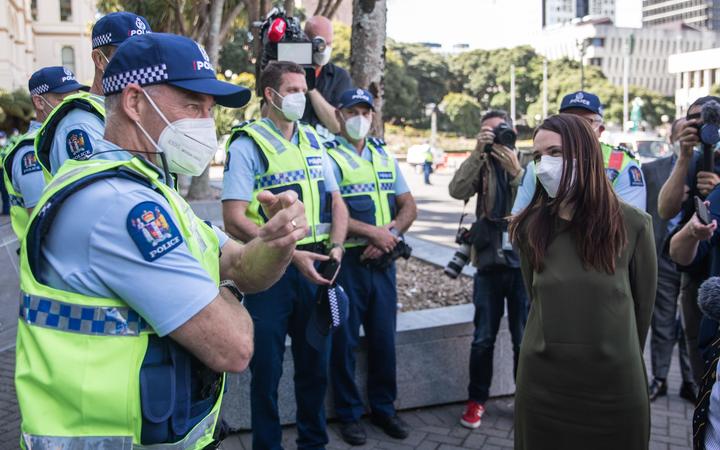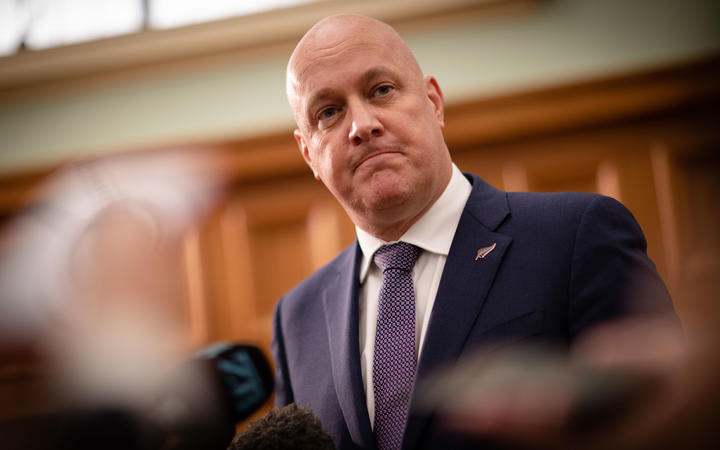Analysis – An end to Managed Isolation and Quarantine (MIQ) allows Kiwis to come home and raises hopes that tourists could soon be here as well, the government reacts to Russia’s invasion of Ukraine and the big clean up begins after a violent end to the occupation of Parliament’s grounds.
 Prime Minister Jacinda Ardern visits Parliament’s grounds after protesters were moved. Photo: RNZ / Samuel Rillstone
Prime Minister Jacinda Ardern visits Parliament’s grounds after protesters were moved. Photo: RNZ / Samuel Rillstone
A fundamental change to Covid-19 management was announced by Prime Minister Jacinda Ardern at her post-Cabinet press conference on Monday and it signalled New Zealand’s border could fully reopen much sooner than expected.
Ardern said Kiwis in Australia could return on Wednesday without having to isolate, several weeks ahead of the planned timeline, and those anywhere else in the world could arrive on Friday.
On 13 March other eligible travellers such as those on working holiday visas and RSE workers would be able to arrive without isolating.
It is the end of MIQ, although a remnant will be retained in case it is needed for a new and even more transmissible variant of Covid-19.
The border has been closed and MIQ has been operating since 19 March 2020 – 689 days, Stuff reported in an editorial which said: “It seems those days are in the past, this week Aotearoa is taking its first steps towards global reconnection.”
The government’s cautious timeline set October as the month the border could open to visitors and tourists from anywhere, and it now seems almost certain to happen sooner than that.
Sir David Skegg, the epidemiologist who heads the Strategic Covid-19 Public Health Advisory Group – the government’s key advisory body – told Morning Report the next few weeks would be very challenging as Omicron reached its peak and it was best to wait till then before making any decisions about tourism.
“We still don’t know where it’s going to end,” he said. “The numbers of people going into hospital every day is increasing, so I’m not surprised they’re (the government) just going to take a bit of time to decide about that, but I expect that tourists will be welcomed to New Zealand earlier than expected.”
Deputy Prime Minister Grant Robertson said on Checkpoint he was confident the border would fully reopen “in the next few months … as we move through March into April we can start to take those decisions”.
The basic reason for the Cabinet’s decision is that with thousands of Omicron cases in the community allowing fully vaccinated returnees in without isolating poses minimal risk.
 Deputy Prime Minister Grant Robertson and Director General of Health Dr Ashley Bloomfield. Photo: Pool / NZME
Deputy Prime Minister Grant Robertson and Director General of Health Dr Ashley Bloomfield. Photo: Pool / NZME
Ardern, however, is still wary about fully reopening the border and allowing “tens of thousands a week” in.
The bottom line is the impact on the hospital system.
Ardern and the Director-General of Health, Dr Ashley Bloomfield, have said it many times – the response is intended to slow down Omicron so that hospitals can cope.
As Omicron approaches its peak, which Ardern has said could be around mid-March or a bit earlier, hospitals are coping but every day they have more Omicron patients.
On Thursday it stood at 503 with seven in ICU.
Neither the government nor Bloomfield will put a figure on what “not coping” means, saying the system adapts as it goes along.
Monday’s good news was followed by Tuesday’s bad news. Bloomfield, fronting a briefing on his own, had to apologise for delays in testing thousands of PCR swabs.
He said it was mainly because the ministry was “a day or two late” to recognise how quickly Omicron was spreading.
Stuff reported him as saying that at its worst 50,000 swabs had been waiting more than five days to be processed and 9000 were sent to Queensland. He gave an assurance the backlog would be quickly cleared.
National and ACT, having been unable to criticise the government for announcing an end to MIQ because they had been calling for it for months, went for Bloomfield.
ACT leader David Seymour said he should resign. “Based on the quality of the management of the pandemic, it is clear he needs to go,” he said.
National Party Covid-19 response spokesman Chris Bishop said Bloomfield had misled the public about the capacity of the testing system.
“Everyone has suspected this, you’ve had multiple experts from the laboratory and from the testing community on the record saying that the system could not cope with the numbers that the ministry said it could,” he said.
For months opposition parties have been criticising the government for the late securing of rapid antigen tests (RATs), and ministers must have been relieved this week when they started arriving in millions.
The RATs were first distributed to testing centres and then retailers began receiving their own. People could walk into a shop this week and buy them, and they did.
“There are fears rapid antigen tests could become ‘the new toilet paper’ as rising Covid-19 infections spark massive demand for the at-home testing kits,” the NZ Herald reported.
It said one Auckland pharmacy sold almost 3000 in a day, there were queues and “desperation” among customers.
Covid-19 Response Minister Chris Hipkins said there was no need to stockpile, the tests had a use-by date and the older they were the less reliable they became.
Prices varied widely. Newshub said one shopper, identified only as Channa, paid $62.99 for a pack of five at Unichem Upper Hutt on Tuesday.
Channa was annoyed when he discovered Pak’nSave supermarkets were selling them for $32.99.
Consumer NZ said it found prices ranging from $6.50 to $19 per test.
The “work from home” Parliament sat for the first time this week, with MPs beaming in and their faces being shown on screens, one positioned over the government benches and the other over the Opposition’s.
“We can safely have all 120 MPs together in the ‘virtual chamber’, just in a different way,” Speaker Trevor Mallard said.
 National leader Christopher Luxon. Photo: RNZ / Angus Dreaver
National leader Christopher Luxon. Photo: RNZ / Angus Dreaver
There were a few MPs in the real debating chamber, widely separated, including the prime minister and opposition leader Christopher Luxon.
It worked as intended, although the chamber is a much quieter and well-behaved place because the work-from-homers can’t interject or jeer at the other side. Only the one speaking can be heard.
Environment Minister David Parker became the first MP to be infected with Covid-19. He tweeted to say he was isolating at home after testing positive on Sunday. He hadn’t been in the Beehive since the previous Monday so hadn’t been with other MPs or staff while infectious.
During the week National called for stronger measures against Russia for invading Ukraine. Luxon wanted the Russian ambassador expelled and New Zealand’s representative withdrawn from Moscow, saying the time for diplomacy was “well and truly over”.
He had previously said the government should pass a law allowing New Zealand to impose autonomous sanctions against Russia and Ardern indicated legislation would soon be in Parliament.
“We are pursuing new measures to target Russian investment including measures to target financial institutions in New Zealand,” she said.
RNZ reported it understood the legislation would allow Russian individuals to be targeted and the bill could be passed next week, with National’s support.
The first item of business for Parliament this week was a motion put up by Ardern condemning Russia for the invasion.
“Slava Ukraini” she said as she introduced it, which Stuff said translated as “glory to Ukraine”. It is the battle cry of the Ukrainian people as they fight the invaders.
The motion was passed unanimously.
On Wednesday, olice moved in to get rid of the protesters who had occupied Parliament’s grounds and nearby streets for three weeks.
The violent confrontations were live-streamed by RNZ and other media outlets, blanket coverage that almost wiped out all other political news.
On Thursday morning the damage done to the precinct could be seen for the first time. The usually beautifully kept lawn had been destroyed and graffiti covered every piece of masonry the protesters could get to. The slide in the children’s playground had been set on fire but was still standing.
Parliament’s only business on Thursday afternoon was the unanimous passing of a motion that pledged the grounds would be restored and thanking the police and emergency services for removing the protesters.
Wellington City Council said it was on standby to carry out a “deep clean” of the grounds because some of the protesters had been infected.
Police said it had been established as a crime scene to allow forensic investigators to identify those responsible for arson and other crimes, Stuff reported.
Discussions about what happens next have started. On Thursday night Speaker Trevor Mallard said Parliament would have to have a wall and gates that could be closed, but he wanted to “retain the openness and accessibility of our House and grounds”.
Deputy Prime Minister Grant Robertson, the local MP, told Morning Report he had been confident throughout that buildings would not be breached but nevertheless, the protesters’ actions had been disturbing.
“There will be a review of the overall security arrangements for Parliament. It is a really careful balance that we have to strike,” he said.
